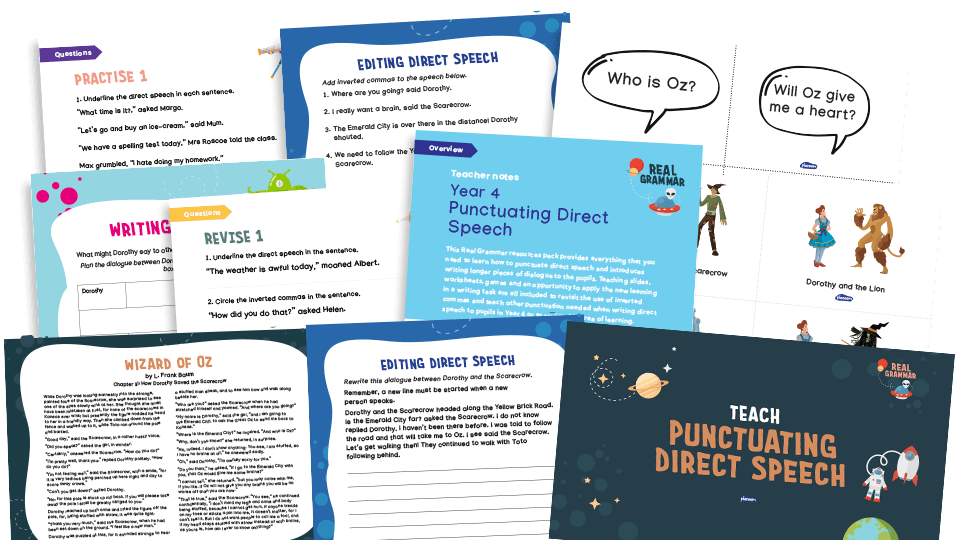4.4b Year 4: using and punctuating direct speech KS2 (other punctuation and moving the reporting clause)

Resource Collection
Real Grammar

Download your resource
Download nowThis resource is part of our grammar curriculum

- Covers every objective for years 1-6
- Five-step sequence ensures deep understanding
- Includes asssessment and revision tools
This Real Grammar Key Stage 2 resources pack provides everything that you need to learn how to punctuate direct speech and introduces writing longer pieces of dialogue to the pupils. Teaching slides, worksheets, games and an opportunity to apply the new learning in a writing task are all included to revisit the use of inverted commas and teach other punctuation needed when writing direct speech in KS2 to pupils in Year 4 or to revisit this area of learning.
Inverted commas are introduced in Year 3. A Real Grammar resource pack is available for pupils who need to revisit the use of inverted commas before looking at other punctuation needed when writing direct speech. Reporting verbs are explored in more detail in a separate Year 4 Real Grammar resource pack.
What is direct speech?
Direct speech is when the exact words that someone says are written.
- “We are going on an adventure,” said Travis.
How do we punctuate direct speech?
Inverted commas, or speech marks, are used when writing direct speech. The inverted commas go around what is said within a sentence. Other speech punctuation is also needed. Punctuation is needed at the end of the direct speech before the inverted comma, and a comma is used after the reporting clause if this comes before the direct speech.
- “We are going on an adventure,” said Travis.
- Travis said, “We are going on an adventure.”
What is the reporting clause?
The reporting clause is the short clause that can come before or after the direct speech that states who was talking. It can also show how the speech was said.
- “We are going on an adventure,” announced Travis.
What is dialogue?
Dialogue is a conversation between two or more people in a book, play or film. The direct speech within the dialogue must be punctuated correctly when written as a narrative.
What is included in this resource pack?
This pack is divided into five parts:
TEACH
This section includes PowerPoint teaching slides and teaching notes with an optional script to introduce using and punctuating direct speech. It can also be used to revisit this aspect of grammar with pupils.
PRACTISE
An independent activity for pupils to practise using what they have been taught, allowing teachers to assess understanding.
REVISIT
A series of short, 10-minute activities that can be used following the TEACH session to revisit and rehearse what has been taught. These may be short writing tasks, grammar games or editing/proofreading activities.
APPLY
A short writing task where pupils can use the grammar skills taught in context to produce independent writing.
REVISE
Five SATs style test questions, including cloze activities and multiple choice quiz questions, based on the grammar that has been taught.
Teachers can choose which section of the resource pack to use according to their pupils’ needs and could use the activities over a series of lessons or weeks
Teacher notes are provided to show how these quality resources could be used with pupils.
How is this resource pack differentiated?
The PRACTISE and REVISE sections include three activities differentiated for three levels of ability:
- Worksheet 1 for pupils who may need support. Questions will have a lower cognitive domain (what is being asked of pupils) and/or vocabulary used may be simplified where possible.
- Worksheet 2 for pupils working at age related expectations.
- Worksheet 3 for pupils who may need an additional challenge and may be working at a greater depth in this area. Questions will have a higher cognitive domain with more challenging vocabulary.
SUPPORT and CHALLENGE ideas are also included in the teacher notes of each section where relevant, with ideas of how to support pupils working towards the expected standard or at greater depth in this area.
What pupil-facing resources are included?
- TEACH
PPT slides; model text: an extract from The Wonderful Wizard of Oz by L Frank Baum
- PRACTISE
Practise 1, Practise 2 and Practise 3 worksheets
- REVISIT
Game 1, game 2
- APPLY
Planning sheet, images
- REVISE
PPT slides; Revise 1, Revise 2 and Revise 3 worksheets
Answer sheets for all worksheets are provided, where appropriate.
This resource is part of the Real Grammar collection.
View more from this collection
Look inside!
Click through to see what this resource has to offer
More from this collection
Browse by Year Group
Year
1
Year
2
Year
3
Year
4
Year
5
Year
6
Upgrade now
Click 'Upgrade now' to activate your subscription. An invoice will appear on your accounts page and be sent by email. Once paid, the benefits of your full account will be unlocked within five days.











